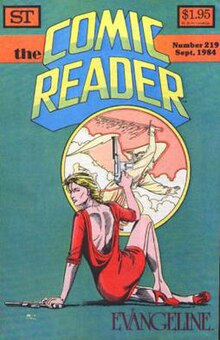The Comic Reader

The cover of the final issue of The Comic Reader, featuring Evangeline.
|
|
| Editor |
Jerry Bails (issues #1–25) Glen Johnson (issues #26–40) Derrill Rothermich (issues 42–48) Bob Schoenfeld (issues #49–64) Mark Hanerfeld (issues #65–77) Paul Levitz (issues #78–100) Mike Tiefenbacher (issues #101–219) |
|---|---|
| Categories | comic book advertising, art, strips, news, reviews, and criticism |
| Frequency | Generally monthly |
| Publisher | Jerry Bails (1961–1963) |
| Total circulation (c. 1972) |
3,500 |
| First issue | Oct. 7, 1961 |
| Final issue — Number |
Sept. 1984 219 |
| Company |
Academy of Comic-Book Fans and Collectors (1963–1969) TCR Publications (1971–1973) Street Enterprises (1973–1982) |
| Country | United States |
| Based in |
Brooklyn, New York (1971–1973) Menomonee Falls, Wisconsin (1973–1984) |
| Language | English |
The Comic Reader (TCR) was a comics news-fanzine published from 1961 to 1984. Debuting in the pre-direct market era (before the proliferation of comics retailers), TCR was the first regularly published comics industry news fanzine, and was able to secure many contacts from within the ranks of the larger publishers. As TCR increased in popularity and influence, it was able to attract professional artist to illustrate the covers. TCR also proved to be a launching pad for aspiring comic book creators, many of whom published work in the fanzine as amateurs. Contributors from the world of fandom included founding editor Jerry Bails, key editor Paul Levitz, Paul Kupperberg, Tony Isabella, Byron Preiss, Neal Pozner, Don Rosa, Carl Gafford, and Doug Hazlewood.
The fanzine was founded in 1961 as On the Drawing Board by Jerry Bails, the "Father of Comics Fandom;" changing its name to The Comic Reader in 1962 and being named the official bulletin of the Academy of Comic-Book Fans and Collectors (ACBFC). During its run, TCR won a number of industry awards, including the Alley Award and the Goethe Award/Comic Fan Art Award. In its last incarnation, published by Street Enterprises, it was more professional magazine than fanzine, and was known colloquially as "the TV Guide of the comics industry."
...
Wikipedia
